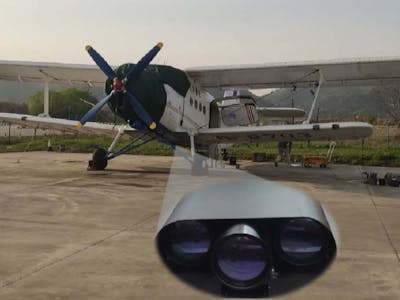Researchers from the University of Science and Technology of China, the University of the Chinese Academy of Sciences, and the CAS Shanghai Institute of Technical Physics have come up with a single-photon lidar system that, they say, can deliver high-resolution 3D images with a low-power laser — making for a smaller and lighter sensor system for drones and more.
“Using single-photon lidar technology on resource-limited drones or satellites requires shrinking the entire system and reducing its energy consumption,” explains Feihu Xu of the problem the team set out to solve.
“We were able to incorporate recent technology developments into a system that, in comparison to other state-of-the-art airborne lidar systems, employs the lowest laser power and the smallest optical aperture while still maintaining good performance in terms of detection range and imaging resolution.”
A more compact lidar sensor system (a), which uses low-powered lasers and SPAD detectors (c), could make 3D aerial mapping from drones and satellites more accessible. (📷: Hong et al)
Like rival systems, the team’s lidar is a light-based alternative to radar for determining the distance between the sensor and an object. Where it differs, though, is that the transmitted laser light is detected by ultra-sensitive single-photon avalanche diode (SPAD) arrays — meaning they’re capable of working with a much lower-power laser than their rivals and using a more compact 47mm (around 1.85″) aperture for the receiving lens. Coupled with sub-pixel scanning and a novel 3D deconvolution algorithm, the sensor can deliver high-resolution daytime 3D scans from drones, airplanes, or even satellites.
“A key part of the new system is the special scanning mirrors that perform continuous fine scanning, capturing sub-pixel information of the ground targets,” Xu explains. “Also, a new photon-efficient computational algorithm extracts this sub-pixel information from a small number of raw photon detections, enabling the reconstruction of super-resolution 3D images despite the challenges posed by weak signals and strong solar noise.”
In testing, the prototype lidar system delivered a 15cm scanning resolution targeting objects at a 1.5km distance (around 5.9″ at one mile) — which improved to 6cm (around 2.4″) once the sub-pixel scanning and deconvolution systems were activated.
The team tested the sensor on a small aircraft, delivering a 6cm resolution at a 1.5km range. (📷: Hong et al)
“Ultimately, our work has the potential to enhance our understanding of the world around us and contribute to a more sustainable and informed future for all,” Xu claims.
“For example, our system could be deployed on drones or small satellites to monitor changes in forest landscapes, such as deforestation or other impacts on forest health. It could also be used after earthquakes to generate 3D terrain maps that could help assess the extent of damage and guide rescue teams, potentially saving lives.”
The team’s work has been published under open-access terms in the journal Optica.

